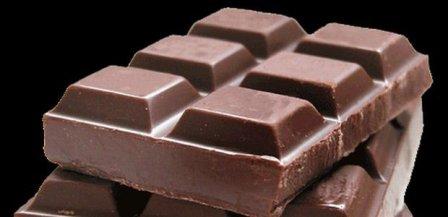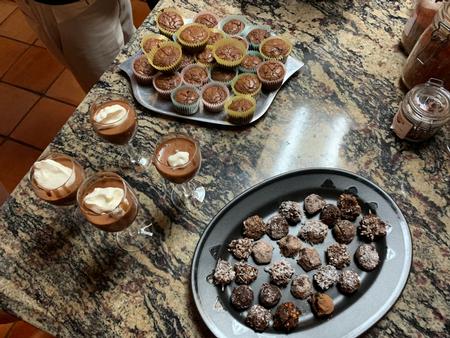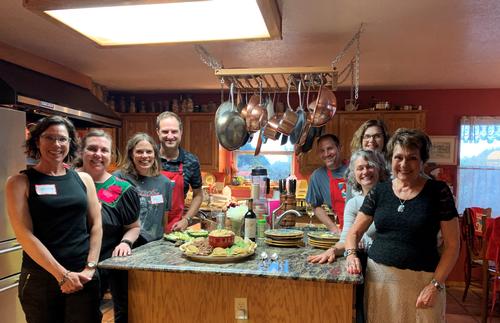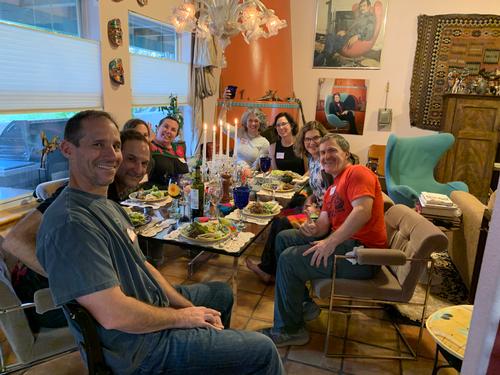Chocolate and Chile--Ancient Companions, Class Discounted
 The Aztecs are credited with discovering chocolate and the word for chocolate in the Aztec language is bitter water. This bitter drink was created for men going to fight battles and to kind of temper the bitterness they preferred to add cinnamon.
The Aztecs are credited with discovering chocolate and the word for chocolate in the Aztec language is bitter water. This bitter drink was created for men going to fight battles and to kind of temper the bitterness they preferred to add cinnamon.
All cinnamon was brought over from China and was quite rare. So as a substitute, when there was no cinnamon around, they stirred in red chiles. To my knowledge, they were the first to combine the two! (Just a historical note, still the best cinnamon in the world is from southern China and comes from the bark of the special cinnamon pine trees that grow there. The Vietnamese are now growing those trees and calling it Saigon cinnamon. The true Chinese cinnamon is often called canela, the Spanish word for cinnamon as the Mexicans import the cinnamon for the American market and that is what we sell in the stick form which is rather thin and flaky and much more flavorful and aromatic than any other available kind in the US)
Now chocolate and chile are a rather familiar blend, yet not terribly familiar. One of my first recollections of the combination was from a years old movie that featured a French woman who owned a little chocolate shop where she sold chocolates laced with chile.
Honestly, there is so much to know about chocolate and learning about chocolate and how the beans are roasted and worked is totally amazing. In our tour to Oaxaca, we learn a great deal about basic chocolate preparation from the raw beans to the roasting and grinding. I have fond memories as a child, seeing what looked like a type of metal corn sheller stationed on the sidewalks scattered throughout the city. These were grinders for chocolate .
 From the cocoa beans initial history of development in Mexico, they have made their way around the globe and will only grow within 20 degrees of either side of the equator. As with all agricultural products, the growing conditions affect the flavor of the chocolate, from earthy flavors stemming from moist climates to more pronounced and sharper flavors from drier climates. Also, the variety of beans determines the delicacy or strength of the flavor. The three basic types of beans are Criollo,, Trinitario and Forastero. As you can imagine, each has its own very special taste characteristics, as well as the growing conditions where they are grown. At the consumer or grocery store level, the percentage of cocoa is not as important to taste as the type and growing conditions. Most important, purchase the best quality you can afford as the brands do have their own quality standards.
From the cocoa beans initial history of development in Mexico, they have made their way around the globe and will only grow within 20 degrees of either side of the equator. As with all agricultural products, the growing conditions affect the flavor of the chocolate, from earthy flavors stemming from moist climates to more pronounced and sharper flavors from drier climates. Also, the variety of beans determines the delicacy or strength of the flavor. The three basic types of beans are Criollo,, Trinitario and Forastero. As you can imagine, each has its own very special taste characteristics, as well as the growing conditions where they are grown. At the consumer or grocery store level, the percentage of cocoa is not as important to taste as the type and growing conditions. Most important, purchase the best quality you can afford as the brands do have their own quality standards.
 If you would like to join our November 11, Chocolate and Chile class, I will share some of my favorite recipes marrying the two ingredients as well as explaining some of the history and facts about the pleasures and enjoyment as well as the techniques that yield quality chocolate dishes. This popular class is set for November 11 at 5 PM. (P.S. You will be able to sample as well as take some home for later enjoyment.)
If you would like to join our November 11, Chocolate and Chile class, I will share some of my favorite recipes marrying the two ingredients as well as explaining some of the history and facts about the pleasures and enjoyment as well as the techniques that yield quality chocolate dishes. This popular class is set for November 11 at 5 PM. (P.S. You will be able to sample as well as take some home for later enjoyment.)
Two other classes are featured for the rest of the year, Southwest Holidays on December 2 and Gifts from a Southwest Kitchen on December 16. We will be scheduling classes for the first of the year very soon. They make wonderful gifts. As I've heard a lot lately, especially with the supply shortages, experiences make life long memories, more than giving objects.
We are also conducting lots of private and team building classes.
 Last Saturday afternoon, we conducted a full participation cooking class to benefit the Albuquerque Museum and hosted by Dr. Margaret Nolan for 8 people. We donated this class, an Oaxacan Mole Party to compliment the Frida Kahlo exhibit.
Last Saturday afternoon, we conducted a full participation cooking class to benefit the Albuquerque Museum and hosted by Dr. Margaret Nolan for 8 people. We donated this class, an Oaxacan Mole Party to compliment the Frida Kahlo exhibit.
Everyone had a grand time--here's a couple of photos. We made the Mole below and Mole Verde with Memelita appetizers, an Acapulco Salad and Flan.
Mole Verde with Memelita appetizers, an Acapulco Salad and Flan.
Following are two recipes that combine chile and chocolate. (The mole is one the above group prepared along with Mole Verde and a special Peppered Rice dish.)
AUNT VIRGINIA'S MOLE
There are several varieties of Moles. Oaxaca claims being the capital of Moles and that there are seven essential Moles. This recipe is from my aunt who was originally from Monterey, Mexico. It is a simplified version of a Mole and my uncle claimed that it was the best he had ever eaten.
Yield: 6 servings
1 (3 1/2 lb.) chicken, cut into serving pieces
2 quarts chicken stock
3 corn tortillas
3 Tablespoons raisins
1 to 2 ounces unsweetened chocolate
1/4 cup slivered almonds
1/2 onion, quartered
1 medium-size green bell pepper, roughly chopped
1 large tomato, quartered
2 garlic cloves, peeled
2 Tablespoons crushed Caribe chile
1/2 teaspoon ground cinnamon
Steamed rice
- Arrange chicken in a large pot. Add stock, and cook until tender but not falling apart, 1 to 1-1/2 hours. Lift chicken out of stock and cool slightly. Remove the skin and bones from the chicken , leaving the pieces of chicken in fairly large piec
- Reserve stock. Process tortillas, raisins, chocolate, almonds, onion, bell pepper, tomato, and garlic in a food processor or blender until finely ground. Add enough stock to make a thick gravy-like sauce. Add crushed chile and cinnamon. Pour sauce into a large pot and simmer until the flavors blend and the sauce has a silken appearance.
- Aboiut 15 to 20 minutes before serving add chicken pieces and simmer to heat chicken thoroughly. If mixture becomes too dry, add more stock. Serve hot with rice.
HOT FUDGE BROWNIES
These are double rich with chocolate and almost fudge-like. The heat of the Caribe chile makes them totally unique. They can be frozen for at least 90 days.
Oven Temperature: 350F Baking Time: 20 minutes
Yield: 8 to 12 brownies
2 1-ounce squares unsweetened chocolate
½ cup sweet (unsalted) butter
2 eggs
1 cup granulated sugar
1 Tablespoon molasses
1 teaspoon Mexican vanilla
½ cup all-purpose flour
1 tablespoon Caribe (crushed northern New Mexico chile)
¼ teaspoon salt
½ cup pecans or other nut, chopped
10. Preheat the oven to 350F. Lightly butter a 9x9-inch square pan. Melt 2 squares of the chocolate with the butter over low heat, stirring frequently. Using a mixer or food processor, beat the eggs; add the sugar, molasses, and vanilla; mix well on medium speed.
11. Add the butter-chocolate mixture. Add the flour, chile, salt and nuts and mix well. Pour into the baking pan, smoothing the batter to the edges in an even layer. Bake 20 minutes or until an inserted knife or toothpick comes out clean. Cool on a rack.
12. Once cool, brownies can be frosted, if desired. Keep brownies covered to prevent drying out.
Search Blog
Subscribe to Blog
Categories
Tags
Baking barbecue cookbook Benefits of Pure Chiles blue corn products chii chile and tomatillo seeds Chiles Cinnamon discounted cooking classes Discounted products Flan full particiipation cooking class Hotter Than Hell New Mexican Holiday Favorites Oaxaca Oaxacan recipes pure ground chiles Quick and Easy Recipe week long cooking class weekend cooking class western book© Copyright 2025 All Rights Reserved. TEX MEX Inc. Privacy Policy.
Jane Butel Cooking School • Pecos Valley Spice Co. • Corrales, NM 87048 • Office: 505-243-2622 • info@janebutelcooking.com | Jane Butel Home Page
To ensure delivery of emails from my website please whitelist: info@janebutelcooking.com





